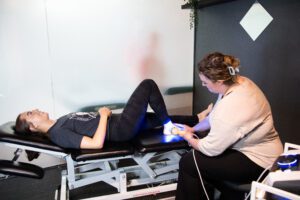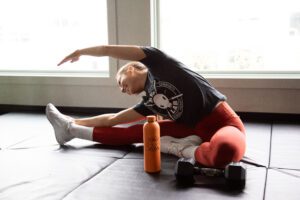
15 Jul Physiotherapy Exercises You Can Do at Home
Physiotherapy plays a vital role in recovery and maintaining overall health. While visiting a Physiotherapist is essential for a tailored treatment plan, there are numerous exercises you can perform at home to supplement your therapy. This guide will explore various home Physiotherapy exercises recommended by MYo Lab Health & Wellness Calgary. These exercises can help improve mobility, reduce pain, and enhance strength.
The Importance of Home Physiotherapy Exercises
Home Physiotherapy exercises are crucial for maintaining progress between sessions with your Physiotherapist. They help reinforce the treatments and techniques learned during your appointments. Furthermore, these exercises provide several benefits, such as:
- Consistency: Regular exercise ensures that you maintain the gains made during Physiotherapy sessions, focusing on establishing improved movement patterns.
- Convenience: Being able to exercise at home allows you to fit therapy into your schedule more easily.
- Cost-Effective: Home exercises reduce the need for frequent visits to the clinic, thereby saving time and money.
- Empowerment: Performing exercises at home empowers you to take an active role in your recovery and health maintenance.
Essential Home Physiotherapy Exercises
Here are some effective home Physiotherapy exercises that you can incorporate into your daily routine. These exercises target various parts of the body and are designed to improve strength, flexibility, and mobility.
1. Lower Back Pain Exercises
Lower back pain is a common issue that can be improved with functional core exercises. At MYo Lab Health & Wellness Calgary, we recommend the following exercises:
Oblique Breathing
Oblique breathing helps in engaging the core muscles and reducing lower back pain. This exercise focuses on controlled breathing and core stabilization.
Deadbug
The deadbug exercise is excellent for strengthening the core and stabilizing the lower back. This exercise helps in improving overall core stability and reducing back pain.
2. Shoulder Exercises
Maintaining shoulder mobility and strength is essential, especially for those with shoulder pain or injuries. Therefore, try these exercises:
Foam Roll Shoulders
The foam roll shoulders exercise helps in releasing tension in the shoulder muscles and improving mobility. It is beneficial for individuals experiencing shoulder stiffness or discomfort.
Posture Angel
The posture angel exercise is designed to improve shoulder mobility and strengthen the upper back. It is particularly effective for individuals with poor posture and shoulder pain.
3. Knee Strengthening Exercises
Stretching and mobilization are crucial for recovering from knee injuries or surgery. Moreover, they help improve stability and reduce pain. Consider these options:
Superband Knee
The superband knee exercise focuses on improving knee strength and stability. This exercise is beneficial for individuals recovering from knee injuries or surgeries.
Couch Stretch
The couch stretch is excellent for stretching the hip flexors and improving knee mobility. It helps in reducing knee pain and enhancing flexibility.
4. Ankle and Foot Exercises
Improving ankle strength and flexibility is essential for maintaining balance and preventing injuries. Therefore, try these exercises:
Short Foot
The short foot exercise helps in strengthening the intrinsic muscles of the foot. It is beneficial for improving balance and preventing foot injuries.
Banded Dorsiflexion
The banded dorsiflexion exercise focuses on improving ankle flexibility and strength. It is particularly useful for individuals with limited ankle mobility.
Tips for Performing Home Physiotherapy Exercises
While home Physiotherapy exercises are beneficial, it is crucial to perform them correctly to avoid injury and maximize effectiveness. Here are some tips:
- Follow Your Physiotherapist’s Advice: Always follow the guidance and recommendations provided by your Physiotherapist.
- Start Slowly: Begin with lower intensity and gradually increase the difficulty as your strength and flexibility improve.
- Consistency is Key: Regular exercise is vital for progress. Try to incorporate these exercises into your daily routine.
- Listen to Your Body: Pay attention to your body’s signals. If you experience pain or discomfort, stop the exercise and consult your Physiotherapist.
Conclusion
In conclusion, home Physiotherapy exercises play a vital role in supporting your recovery and maintaining physical health. By following these exercises and tips, you can complement the treatments provided by your Physiotherapist and achieve better health outcomes. At MYo Lab Health & Wellness Calgary, we are committed to helping you on your journey to recovery. For personalized advice and tailored treatment plans, do not hesitate to contact us.
To learn more about our Physiotherapy services, visit our Physiotherapy Services page or contact us to schedule a consultation.
Related Articles:
- The Benefits of Physiotherapy
- How Physiotherapy Can Help Manage Chronic Pain
- Tips for Recovering from Sports Injuries
Related Posts
 Preventative Physiotherapy: How to Avoid Injuries Injuries can disrupt daily life and hinder physical activities, but with proactive measures through preventative Physiotherapy, many can be avoided altogether. At MYo Lab Health… Read more
Preventative Physiotherapy: How to Avoid Injuries Injuries can disrupt daily life and hinder physical activities, but with proactive measures through preventative Physiotherapy, many can be avoided altogether. At MYo Lab Health… Read more How Physiotherapy Can Improve Your Workout Routine How Physiotherapy Can Improve Your Workout Routine Are you looking to enhance your workout routine and achieve better results? Physiotherapy can be a game-changer in… Read more
How Physiotherapy Can Improve Your Workout Routine How Physiotherapy Can Improve Your Workout Routine Are you looking to enhance your workout routine and achieve better results? Physiotherapy can be a game-changer in… Read more The Best Stretches Recommended by Physiotherapists Stretching is an essential component of maintaining flexibility, preventing injuries, and improving overall physical performance. Physiotherapists, with their expertise in human anatomy and movement, recommend… Read more
The Best Stretches Recommended by Physiotherapists Stretching is an essential component of maintaining flexibility, preventing injuries, and improving overall physical performance. Physiotherapists, with their expertise in human anatomy and movement, recommend… Read more Physiotherapy for Back Pain Relief Back pain is a common ailment that affects millions of people worldwide. Fortunately, Physiotherapy offers effective solutions for back pain relief. At MYo Lab Health… Read more
Physiotherapy for Back Pain Relief Back pain is a common ailment that affects millions of people worldwide. Fortunately, Physiotherapy offers effective solutions for back pain relief. At MYo Lab Health… Read more